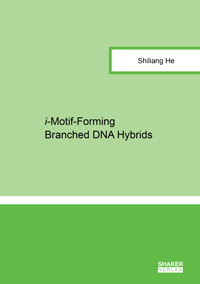
Shop : Details
Shop
Details
48,80 €ISBN 978-3-8440-5909-0Softcover172 pages153 figures255 g21 x 14,8 cmEnglishThesis
April 2018
Shiliang He
i-Motif-Forming Branched DNA Hybrids
Materials that are able to transition among three states (solution, gel, solid) are rare to find. By using a non-canonical DNA secondary structure, i-motif, as the intermolecular association force in the assembly of branched DNA hybrids, a system transit among the three states was developed. The DNA hybrids consisted of a branching point, tetrakis(4-resorcinylphenyl)adamantane (TRPA), and 8 DNA arms containing 2-4 deoxycytosine nucleotides. They were synthesized by block condensation between TRPA and the oligonucleotides in H-phosphonate form which was prepared from commercial phosphoramidite. After deprotection, the crude products were purified by reverse-phase cartridge or HPLC, and ion-exchanged to sodium form to achieve higher solubility. I-motif-induced aggregation was confirmed by NMR, UV-melting, gel electrophoresis and TEM experiments. In the presence of divalent cations, the hybrids formed porous solids from solutions with micromolar to milimolar concentrations, which took up cationic DNA intercalators or dyes selectively. At a weight percentage of around 1.0 %, the hybrids formed hydrogels under acidic conditions, which could be switched to solution states by changing to basic pH or higher temperature. Therefore, different stimuli, i.e. the change of divalent cation concentration, pH and temperature changes, could be used to realize the solution-hydrogel-solid transitions in aqueous medium, which is promising for applications in drug delivery and chemicals separation.
Keywords: Oligonucleotides; DNA; smart materials; hydrogels
Export of bibliographic data
Shaker Verlag GmbH
Am Langen Graben 15a
52353 Düren
Germany
Am Langen Graben 15a
52353 Düren
Germany
Mon. - Thurs. 8:00 a.m. to 4:00 p.m.
Fri. 8:00 a.m. to 3:00 p.m.
Fri. 8:00 a.m. to 3:00 p.m.
Contact us. We will be happy to help you.



